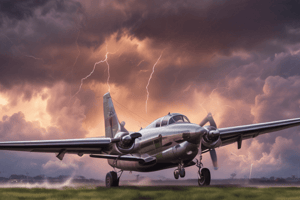Podcast
Questions and Answers
What is the primary concern when dealing with thunderstorms in aviation?
What is the primary concern when dealing with thunderstorms in aviation?
- Aircraft's aerodynamic integrity
- Pilot's visibility during landing
- Thorough pre-flight weather briefings
- Vigilance and adherence to safety protocols (correct)
What is the importance of understanding thunderstorm characteristics in aviation?
What is the importance of understanding thunderstorm characteristics in aviation?
- To navigate through heavy rain
- To optimize flight paths for fuel efficiency
- To enhance flight safety and decision-making (correct)
- To determine the severity of hail damage
What should pilots do when faced with reduced visibility during landing?
What should pilots do when faced with reduced visibility during landing?
- Abort the landing and divert to an alternate airport
- Rely on instruments and continue the approach
- Attempt to regain visual contact with the runway
- Follow standard operating procedures (correct)
What is the primary cause of the aircraft's compromised aerodynamic integrity in Case Study 3?
What is the primary cause of the aircraft's compromised aerodynamic integrity in Case Study 3?
What is the significance of real-time weather updates in aviation?
What is the significance of real-time weather updates in aviation?
What is the primary lesson learned from Case Study 4?
What is the primary lesson learned from Case Study 4?
What should pilots do when faced with unforeseen weather conditions?
What should pilots do when faced with unforeseen weather conditions?
What is the common thread among the lessons learned from the case studies?
What is the common thread among the lessons learned from the case studies?
What is the primary consequence of hail damage to an aircraft's windshield?
What is the primary consequence of hail damage to an aircraft's windshield?
What is the significance of making use of all available meteorological data in aviation?
What is the significance of making use of all available meteorological data in aviation?
The anvil of a thunderstorm can extend up to 10 miles from the core.
The anvil of a thunderstorm can extend up to 10 miles from the core.
Wind shear can cause an aircraft's airspeed to fluctuate rapidly during climb.
Wind shear can cause an aircraft's airspeed to fluctuate rapidly during climb.
The crew in Case Study 1 managed to avoid the thunderstorm cell entirely.
The crew in Case Study 1 managed to avoid the thunderstorm cell entirely.
The pilots in Case Study 2 performed an emergency landing after experiencing wind shear.
The pilots in Case Study 2 performed an emergency landing after experiencing wind shear.
Thunderstorms are the most common weather-related challenge to aviation.
Thunderstorms are the most common weather-related challenge to aviation.
The aircraft in Case Study 1 sustained hail damage to its windshield.
The aircraft in Case Study 1 sustained hail damage to its windshield.
The case studies presented examine hypothetical incidents involving thunderstorms.
The case studies presented examine hypothetical incidents involving thunderstorms.
The crew in Case Study 1 experienced severe turbulence, but the aircraft did not sustain any damage.
The crew in Case Study 1 experienced severe turbulence, but the aircraft did not sustain any damage.
Wind shear can cause an aircraft's altitude to fluctuate rapidly during cruise.
Wind shear can cause an aircraft's altitude to fluctuate rapidly during cruise.
The importance of maintaining a safe distance from thunderstorm cells is emphasized in Case Study 1.
The importance of maintaining a safe distance from thunderstorm cells is emphasized in Case Study 1.
In what phase of flight is an aircraft most vulnerable to thunderstorm-related hazards?
In what phase of flight is an aircraft most vulnerable to thunderstorm-related hazards?
What is the critical moment during a thunderstorm when pilots must make a decision to either continue or divert?
What is the critical moment during a thunderstorm when pilots must make a decision to either continue or divert?
What is the primary benefit of understanding the characteristics of thunderstorms in aviation?
What is the primary benefit of understanding the characteristics of thunderstorms in aviation?
What is the common thread among the lessons learned from the case studies?
What is the common thread among the lessons learned from the case studies?
What is the primary consequence of inadequate pre-flight weather briefings?
What is the primary consequence of inadequate pre-flight weather briefings?
What is the significance of flexibility in flight planning when dealing with thunderstorms?
What is the significance of flexibility in flight planning when dealing with thunderstorms?
What is the primary risk associated with wind shear during climb?
What is the primary risk associated with wind shear during climb?
What is the primary goal of obtaining detailed weather briefings?
What is the primary goal of obtaining detailed weather briefings?
What is the significance of real-time weather updates in reducing the risk of thunderstorm-related hazards?
What is the significance of real-time weather updates in reducing the risk of thunderstorm-related hazards?
Flashcards are hidden until you start studying
Study Notes
Thunderstorm Avoidance and Management
- Evaluating safe altitude levels is crucial when flying over thunderstorms to maintain airplane operability and passenger comfort.
- In-flight diversion may be necessary in case of unavoidable thunderstorm activity, requiring clear and concise communication with air traffic control.
Thunderstorm Characteristics and Dangers
- Thunderstorms are formidable weather phenomena that can pose hazards such as extreme turbulence, hail, lightning, and wind shear.
- Cumulonimbus clouds, often accompanied by heavy precipitation, are a warning sign for pilots to exercise vigilance.
- The anvil shape and sound of thunder are natural warnings that should dictate a pilot's next move.
Flight Planning and Preparation
- Best practice is to avoid thunderstorms during flight planning by reviewing weather briefings and proactively planning a route to steer clear of known thunderstorm activity areas.
- Onboard equipment such as radar systems can detect thunderstorms from afar, allowing pilots to circumnavigate the threat.
- Correct interpretation of radar data is essential to distinguish between non-threatening clouds and potential danger zones.
In-Flight Thunderstorm Management
- Immediate response measures when encountering a thunderstorm include requesting route deviations from Air Traffic Control, securing loose objects in the cabin, alerting passengers, and preparing for potential turbulence.
- Keep a safe distance of at least 20 nautical miles from the storm cell to minimize risk.
- Maintain clear and continuous communication with Air Traffic Control, providing updates on the situation and heeding their advice.
Post-Thunderstorm Protocol
- After navigating through a thunderstorm, inspect the aircraft for any damage and report the encounter to assist in weather tracking and to aid fellow pilots.
Case Studies
Case Study 1: The Anvil Cell Encounter
- A commercial airliner encountered a rapidly developing thunderstorm, resulting in severe turbulence and lightning strikes that caused temporary loss of some avionic systems.
- The incident highlights the importance of maintaining a safe distance from thunderstorm cells, as the anvil can extend several miles from the core, bringing turbulence and lightning risks.
Case Study 2: Wind Shear During Approach
- A regional jet on final approach encountered wind shear caused by a nearby thunderstorm, resulting in rapid airspeed fluctuations and struggles to maintain a stable descent.
- The pilots applied wind shear recovery procedures, increasing thrust and adopting a go-around attitude, to regain control and perform a go-around.
Case Study 3: Hailstorm Damage on Departure
- A light aircraft flew into an unforeseen hail-producing thunderstorm shortly after takeoff, resulting in a shattered windshield and severely dented leading edges.
- The case illustrates the swift onset of adverse conditions associated with thunderstorms and the necessity for thorough pre-flight weather briefings and real-time weather updates.
Case Study 4
- A cargo aircraft was landing during a thunderstorm, resulting in heavy rain and dramatically reduced visibility, which led to a critical moment of lost visual reference to the runway.
- The pilots decided to continue the approach relying on instruments, but post-flight analysis suggested that a missed approach would have been the safer option.
- The case emphasizes the perils of reduced visibility in thunderstorm conditions and the importance of adhering to standard operating procedures when visual references are lost.
Mastering Aviation Meteorology: Thunderstorms
- Thunderstorms pose significant dangers to aviation, including strong up and downdrafts, severe turbulence, hail, and lightning, which can lead to loss of control, structural damage, or worse.
- Understanding the risks associated with thunderstorms is critical for pilots to ensure the safety of their aircraft and passengers.
Identifying Thunderstorms
- Thunderstorms can be identified by their characteristics, such as anvil-shaped clouds, heavy precipitation, and the sound of thunder.
- Pilots must be able to recognize these signs to take necessary precautions.
Pre-Flight Planning
- Comprehensive weather briefings offer a first line of defense against thunderstorms, allowing pilots to understand the day's weather patterns, plot alternative routes, and prepare for potential challenges ahead.
Onboard Weather Radar
- Onboard weather radar is an invaluable tool for identifying and avoiding thunderstorms during flight.
- Radar returns can detect thunderstorms and enable pilots to adjust their flight path accordingly, maintaining a safe distance.
Circumnavigating Thunderstorms
- When encountering a thunderstorm, pilots must evaluate safe altitude levels and consider factors such as the storm's direction, speed, and their aircraft's capabilities.
- Keeping a safe distance, generally at least 20 nautical miles from the storm cell, can minimize the risk.
Managing In-Flight Encounters
- In the event of an unexpected thunderstorm encounter, pilots must follow protocols such as requesting route deviations from Air Traffic Control, securing loose objects in the cabin, alerting passengers, and preparing for potential turbulence.
- Correct interpretation of onboard equipment data is crucial to distinguish between non-threatening clouds and potential danger zones.
Post-Thunderstorm Protocol
- After passing through a thunderstorm, pilots must inspect their aircraft for any damage and report the encounter to assist in weather tracking and to aid fellow pilots.
Case Studies
- Case Study 1: The Anvil Cell Encounter: A commercial airliner encountered severe turbulence and lightning strikes after flying into the anvil of a thunderstorm, highlighting the importance of maintaining a safe distance from thunderstorm cells.
- Case Study 2: Wind Shear During Approach: A regional jet on final approach encountered wind shear caused by a nearby thunderstorm, emphasizing the critical nature of recognizing wind shear early and applying correct response procedures.
Mastering Aviation Meteorology: Thunderstorms
- Thunderstorms pose significant dangers to aviation, including strong up and downdrafts, severe turbulence, hail, and lightning, which can lead to loss of control, structural damage, or worse.
Identifying Thunderstorms
- Characteristics of thunderstorms include towering cumulonimbus clouds, heavy precipitation, and the sound of thunder.
- Anvil-shaped clouds are a warning sign of thunderstorm development.
Pre-Flight Planning and Briefings
- Comprehensive weather briefings offer a first line of defense against thunderstorms, allowing pilots to understand the day's weather patterns and plot alternative routes.
- Reviewing weather briefings and proactively planning routes can help steer clear of known thunderstorm activity areas.
In-Flight Radar and Navigation
- Onboard weather radar is an invaluable tool for identifying and avoiding thunderstorms.
- Correct interpretation of radar data is crucial to distinguish between non-threatening clouds and potential danger zones.
- Pilots should maintain a safe distance of at least 20 nautical miles from the storm cell to minimize risk.
Emergency Protocols
- Immediate response measures in the event of a thunderstorm encounter include:
- Requesting route deviations from Air Traffic Control
- Securing loose objects in the cabin
- Alerting passengers
- Preparing for potential turbulence by adjusting speed to turbulence penetration speed
- Protocols for navigating around thunderstorms include considering the storm's direction, speed, and aircraft capabilities.
- Clear and continuous communication with Air Traffic Control is essential.
Post-Thunderstorm Protocol
- After passing through thunderstorm conditions, pilots should inspect the aircraft for any damage and report the encounter to assist in weather tracking and to aid fellow pilots.
Case Studies
Case Study 1: The Anvil Cell Encounter
- A commercial airliner flew into an anvil cell, experiencing severe turbulence and lightning strikes, but managed to navigate out of the storm without further damage.
Case Study 2: Wind Shear During Approach
- A regional jet on final approach encountered wind shear, but the pilots regained control by applying wind shear recovery procedures.
Case Study 3: Hailstorm Damage on Departure
- A light aircraft flew into an unforeseen hail-producing thunderstorm, resulting in damage to the aircraft's windshield and leading edges.
Case Study 4
- A cargo aircraft landed safely during a thunderstorm, but post-flight analysis suggested that a missed approach would have been the safer option.
Key Lessons Learned
- Vigilance, preparedness, and adherence to established safety protocols are crucial when dealing with thunderstorms.
- Pilots must be proactive in obtaining detailed weather briefings, making use of all available meteorological data, and remaining flexible to alter flight paths in response to evolving weather conditions.
Studying That Suits You
Use AI to generate personalized quizzes and flashcards to suit your learning preferences.




